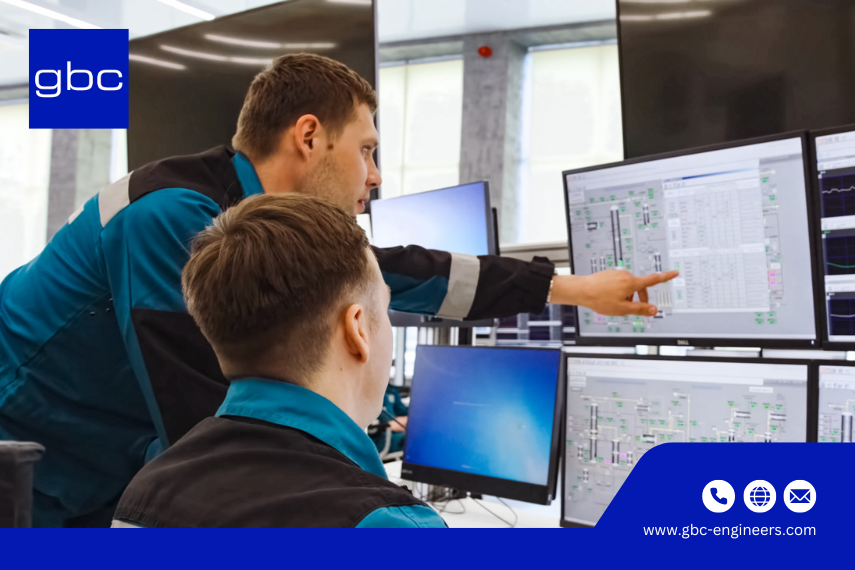Data center monitoring involves tracking critical systems like IT infrastructure, environment, and security to ensure peak performance and resilience.
In this comprehensive guide of gbc engineers, discover the four main types of data center monitoring system, how they work, the tools involved, and best practices for improving uptime, resource usage, and data protection.
What Is Data Center Monitoring?
Data center monitoring refers to the ongoing, real-time tracking of the IT and physical environment metrics that matter most to a business. It encompasses a broad spectrum of tasks: from monitoring server performance, power usage, cooling efficiency, cyber threats, and physical access, to evaluating user experience and service delivery.
When implemented effectively, data center monitoring enables businesses to stay compliant, protect critical information, ensure service reliability, and make data-driven decisions regarding their infrastructure and technology products.
At its core, data center monitoring provides visibility into every aspect of your infrastructure. It offers valuable information about power consumption, network disruptions, temperature fluctuations, and usage surges — all essential for smooth operations.
This level of insight helps business and IT teams adapt to changing demands, improve resource allocation, and deliver consistent service to both internal departments and external customers. For organizations looking to enhance their monitoring capabilities or learn more about specific products and tools, making contact with trusted technology providers is a strategic first step.
Read More: Everything You Didn’t Know About Data Center Components - gbc engineers
Why Data Center Monitoring Is Crucial
- Ensures High Availability: Downtime in a data center can be catastrophic. Monitoring systems detect early warning signs—like overheating servers or power fluctuations—allowing swift corrective actions. This minimizes service interruptions and keeps mission-critical applications running.
- Optimizes Resource Usage: Tracking energy usage, server loads, and network utilization allows data center managers to identify underused assets, balance workloads, and right-size operations. This leads to better energy consumption, reduced waste, and lower operating costs.
- Improves Security: Monitoring includes both physical (cameras, door sensors) and cyber security (firewalls, log tracking, intrusion detection). Unauthorized access, unusual data flows, or login anomalies are flagged immediately to prevent breaches.
- Enhances Environmental Control: Environmental sensors monitor temperature, humidity, airflow, and water leaks. This ensures that infrastructure operates within safe parameters, protecting sensitive equipment from damage or failure.
- Supports Predictive Maintenance: Analyzing long-term data trends allows operators to anticipate equipment failures before they happen. Maintenance can be scheduled proactively, reducing unexpected downtimes and extending equipment life.

Core Types of Data Center Monitoring
1. IT Infrastructure Monitoring
Focuses on servers, storage systems, virtual machines, and networks. Tracks system performance (CPU, memory, disk usage) and ensures that workloads are balanced and running efficiently.
2. Power Monitoring
Tracks power distribution units (PDUs), uninterruptible power supplies (UPS), backup generators, and energy consumption. Monitoring ensures consistent power delivery and helps identify inefficiencies or overdrawn circuits.
3. Environmental Monitoring
Measures heat, humidity, air pressure, airflow, smoke, and moisture. Helps prevent overheating or equipment damage, especially in high-density server environments.
4. Physical Security Monitoring
Includes surveillance cameras, motion detectors, entry control systems, and biometrics. Prevents unauthorized entry and monitors personnel movement within secure zones.
5. Network Monitoring
Monitors bandwidth usage, packet loss, latency, and network topology. Detects unusual activity, bottlenecks, or outages, supporting consistent connectivity and performance.
Read More: Top Strategies to Improve Data Center Asset Management in 2025 - gbc engineers
Key Metrics to Monitor in a Data Center
- Temperature & Humidity: Monitoring systems in server rooms must keep conditions within industry standards to avoid overheating, condensation, or hardware degradation. These metrics are critical to maintaining the long-term health of both equipment and the overall environment.
- Power Usage Effectiveness (PUE): A foundational metric in many case studies, PUE measures the energy efficiency of a data center. Lower PUE values indicate better optimization and sustainable power distribution across IT and non-IT equipment.
- CPU & Memory Utilization: Real-time tracking of processor and memory loads prevents system overloads and enables proactive resource optimization. This data often guides purchasing decisions for scalable infrastructure or new product integrations.
- Disk I/O: Monitoring disk input/output identifies potential storage bottlenecks that can slow down applications or cause data access delays. This is especially important in high-volume environments such as server rooms handling enterprise workloads.
- Uptime/Downtime: A crucial operational metric that reflects service reliability. Monitoring platforms continuously track uptime to ensure maximum availability, which is often documented in service-level agreements and customer-facing case studies.
- Network Throughput: This metric measures the amount of data transmitted through the network over time. It helps identify traffic congestion, packet loss, or the need for infrastructure upgrades to support growing business demands.
- Entry Logs: Monitoring platforms track every entry attempt, detailing who interacted with which components, when, and from where. These logs are essential for verifying compliance, auditing control protocols, and investigating unauthorized intrusion or misuse.
- Cooling System Efficiency: Ensures that airflow and environmental control zones in the server rooms are functioning optimally. Case studies often highlight how improved cooling efficiency reduces costs and boosts system reliability.
- Battery Backup Status: Tracks the health and readiness of power backup systems. By ensuring that the uninterruptible power supply (UPS) product is fully charged and operational, businesses reduce the risk of downtime during outages.

Read More: Why Data Center Tiers Matter for Business Security and Continuity - gbc engineers
Essential Monitoring Tools for Modern Data Centers
In today’s digital economy, robust data center monitoring is critical. Whether you're operating on-premises, managing cloud infrastructure, or delivering hosted services, real-time insight into your systems ensures uptime, performance, security, and compliance. But with so many tools on the market, choosing the right monitoring solution for your environment can be overwhelming.
We’ll explore their key features, strengths, ideal use cases, and best practices to help you decide which platform aligns with your monitoring goals.
Nagios XI
What It Is
Nagios XI is the flagship, enterprise-ready version of the longtime open-source Nagios Core. It's a scalable, extensible platform offering centralized monitoring across IT infrastructure—servers, networks, applications, logs, and services—through a unified, customizable user interface.
Key Features & Benefits
- Comprehensive infrastructure monitoring: Covers servers (physical and virtual), switches, routers, databases, web services, and OS-level health.
- Modular architecture: Leverages Nagios Core with thousands of plugins—both community-contributed and custom—plus easily integrated APIs.
- Flexible alerts & notifications: Supports email, SMS, Slack, Teams, and PagerDuty with configurable escalation paths.
- Capacity planning & trending: Includes automated graphing and trend analysis to forecast resource needs and preempt bottlenecks.
- Customizable dashboards: Personalize views, graphs, and data presentation by role or team, with multi-tenant controls.
- Configuration management: Simplified host/service configuration via wizards, bulk imports, and snapshotting to roll back changes.
Ideal Use Cases
- Mid- to large-size enterprises seeking enterprise-grade monitoring built on open-source.
- Organizations needing plugin affordances for custom or legacy systems.
- Teams requiring detailed capacity planning and alert escalation.
When to Choose Nagios XI
If you want tried-and-true infrastructure monitoring, high customization, multi-site scalability, and handling thousands of devices—with professional support—Nagios XI is a top choice.
Read More: What Are Micro Data Centers and Why Are They Crucial in 2025? - gbc engineers
SolarWinds Orion
What It Is
SolarWinds Orion is a unified, scalable IT infrastructure monitoring platform designed to support hybrid environments—on-prem, cloud, SaaS, and distributed workloads—via a robust modular architecture. It gives full visibility across networks, systems, applications, storage, and user experience.
Key Features & Benefits
- Deep network & server monitoring: Auto-discovery, health tracking, interface stats, and network path analysis.
- Application & cloud visibility: APM, database monitoring, virtualization insight, and cloud service responsiveness.
- Event correlation & alerting: Threshold-based triggers with built-in analytics; customizable alert rules.
- Scalability & module-based design: Start with core modules and grow as needed with add-ons (APM, NPM, SAM, VMAN).
- User behavior analysis: Insight on user paths, session timing, page requests, and real‑user delay.
- Storage resource tracking: Monitors utilization on SAN/NAS, optimizing capacity and predicting shortages.
Ideal Use Cases
- Enterprises needing a single-pane-of-glass solution across networks, virtualized environments, apps, and cloud infrastructure.
- Teams already invested in SolarWinds ecosystem seeking seamless integration.
- Data centers requiring cross-platform monitoring under high scale.
When to Choose SolarWinds Orion
Choose Orion when you need breadth—covering operating systems, networks, storage, applications, and user experience—with scalability and modular growth.

Zabbix
What It Is
Zabbix is a powerful open-source monitoring solution suited for distributed environments—on-premises, virtualized, or hybrid infrastructures. It blends agent-based and agentless methods to track infrastructure, services, web apps, virtual resources, IoT devices, and more.
Key Features & Benefits
- Versatile data collection: Supports SNMP, IPMI, JMX, SSH, telnet, HTTP, and custom scripts for polling and reporting.
- Smart thresholds & trigger logic: Advanced problem detection using multiple metrics, time windows, and correlation.
- Real-time visualization: Live dashboards with drag‑and‑drop widgets, SLA maps, geo‑views, and dynamic network maps.
- Alerting and remediation: Escalation support, notifications via email/SMS/chat, and automated actions like remote commands.
- Scalability: Better for distributed environments thanks to proxy-based monitoring; modular, lightweight agents.
- Rich API and integrations: Seamless integration with ITSM tools, third-party platforms, and DevOps pipelines.
Ideal Use Cases
- Teams needing a free/open-source, feature-rich monitoring platform.
- Environments requiring distributed or hybrid/virtual infrastructure coverage.
- Organizations wanting customizable alert and automated remediation rules.
When to Choose Zabbix
Zabbix is ideal if you want no-cost deployment, strong customization, scalable distributed monitoring, and no vendor lock‑in.
Read More: How to Plan a Successful Data Center Migration in 2025 - gbc engineers
ManageEngine OpManager MSP
What It Is
OpManager MSP is a specialized version of ManageEngine’s infrastructure monitoring solution, designed for managed service providers. It monitors multi-client networks, servers, storage, environment conditions, and applications—centrally and multi-tenant.
Key Features & Benefits
- Multi-tenant architecture: Define separate dashboards, reports, threshold profiles, and credentials per client.
- Network and server monitoring: Tracks device health, statuses, CPU/memory, interfaces, and server stacks.
- Bandwidth & flow analysis: Integrates NetFlow, sFlow, and J‑Flow for traffic capture, usage breakdown, and anomaly detection.
- Application performance: Works seamlessly with Applications Manager to monitor enterprise apps like Oracle, JBoss, WebLogic.
- Data center environment view: Monitors rack temperature, humidity, and thresholds within the same console.
- Visual infrastructure mapping: Builds rack-level and 3D floor maps to visualize real-time statuses at a glance.
Ideal Use Cases
- MSPs managing infrastructure for multiple clients from a centralized platform.
- Data centers needing environment, network, server, and application monitoring with one tool.
- Teams needing flow analytics and traffic breakdown integrated with infrastructure health.
When to Choose OpManager MSP
If you're an MSP or host multiple environments and want consolidated management plus client segregation, OpManager MSP offers a strong solution that balances simplicity, visuals, and depth.
Datadog
What It Is
Datadog is a cloud-native observability platform that indexes log, metric, trace, and security telemetry from infrastructure, apps, networks, containers, and user interactions. Best suited for dynamic, modern, distributed systems, including serverless and microservices.
Key Features & Benefits
- Unified observability: Combines infrastructure, application, network, real user, and threat monitoring.
- Log analytics & correlation: Centralizes logs, enables queries, pattern detection, and correlation with metrics/traces.
- Serverless visibility: Tracks AWS Lambda, Azure Functions, and GCP Cloud Functions usage, duration, and performance.
- RUM & synthetic testing: Measures end-user performance and enables instrumented synthetic API uptime checks.
- Threat monitoring: Includes network traffic analysis, anomaly detection, and vulnerability management dashboards.
- Collaboration and dashboards: Highly customizable, shareable dashboards with role-based controls and alerts.
Ideal Use Cases
- Organizations using cloud-native, containerized, or serverless architectures.
- Teams that require combined logging and metrics with advanced correlation.
- Environments prioritizing threat detection and network observability in one platform.
When to Choose Datadog
Opt for Datadog if your infrastructure is modern, distributed, or hybrid—it gives you deep telemetry with cloud-native agility, security, and analytics.
Read More: How Smart Data Center UPS Design Reduces Operational Costs - gbc engineers
Conclusion
Choosing the right data center monitoring tool is crucial for maintaining performance, minimizing downtime, and scaling your operations securely. Whether you're managing traditional on-premises servers or complex hybrid infrastructures that span virtualized platforms and remote services, tools like Nagios XI, SolarWinds Orion, Zabbix, OpManager MSP, and Datadog provide powerful, flexible monitoring capabilities to keep your systems healthy and your teams informed.
At gbc engineers, we understand the value of real-time insights and infrastructure observability in today’s data-driven world. We rely on industry-proven monitoring solutions to support our mission of delivering reliable, efficient, and sustainable engineering services for high-performance data centers across Europe and Asia.